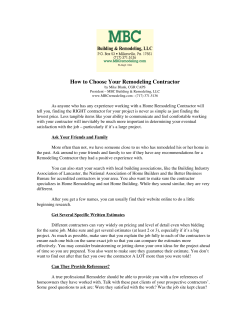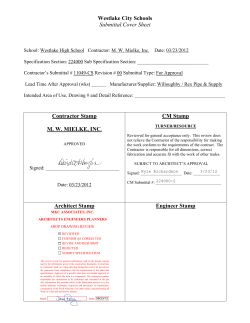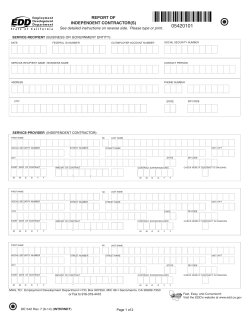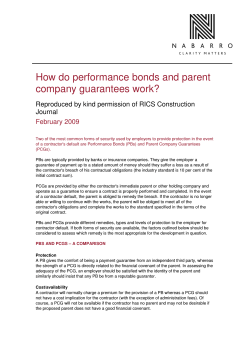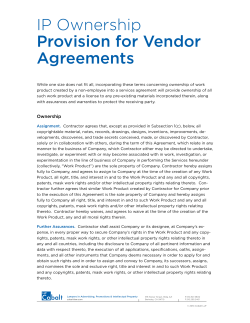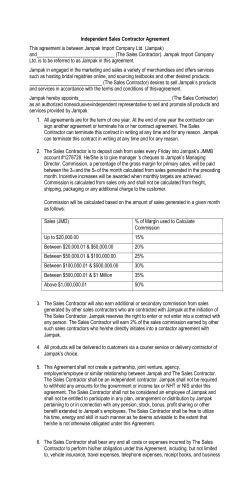
HOW TO MAKE TARGET COST AND COST REIMBURSABLE CONTRACTS WORK
Contract Solutions | E-newsletter Issue 4 HOW TO MAKE TARGET COST AND COST REIMBURSABLE CONTRACTS WORK The use of target cost and cost reimbursable contracts has grown dramatically over the last 10 years supported by the introduction of new contract forms such as the NEC Engineering and Construction Contract (ECC) which contains two target cost options. Conversely if the actual cost is higher than the target cost, there is an overspend and this overspend is then shared between the parties on pre-agreed percentage split. This share of the overspend is referred to as pain share. Target Cost Mechanism Employers Risk Changes Contractors Risk Fee In a series of articles to be published in the Contract Solutions Newsletter we will introduce the theory and practice of target costs and cost reimbursable contracts as well as share the lessons we have learnt and issues that need to be considered in their use. This first article will cover the creation and maintenance of a Target Cost. Final actual cost compared to final targetcost to determine gain share/pain share Certificate 4 Certificate 3 Base Cost Certificate 2 Certificate 1 Target Cost Actual Cost Why use Target Cost Arrangements? How do Target Cost Contracts work The basic principle is that a target cost is agreed and then the contractor is paid for the work undertaken on a cost reimbursable (actual cost) basis. The payments to the contractor are made on the basis of the contractor’s accounts and records, which are provided to the employer for inspection on an ‘open book’ basis. The principle benefit of target cost arrangements is their ability to align the objectives of the parties, which helps to create a partnering environment. The contractor and employer are both encouraged to work together to control costs by the sharing of the risk of over / under spend through the pain share / gain share mechanism. At the end of the project the final target cost, which is the original target cost plus any agreed changes, is compared to the actual cost expended by the contractor. Target cost contracts were originally developed in the infrastructure sector to deal with complex projects that had a high degree of risk around items such as ground conditions, due to their ability to share risk through the pain share / gain share mechanism. If the actual cost is lower than the target cost, a saving has been made which is then shared between the parties on a pre-agreed percentage basis. This share of the saving is referred to as gain share. As the contractor is remunerated on a cost reimbursable basis they have to give the employer access to their accounts and records on an ‘open book’ basis. This open book approach helps to build trust between the parties through Contract Solutions | E-newsletter Issue 4 the sharing of information by the contractor and visibility from the employer of the true cost of the project to the contractor. A target cost contract can accommodate change easier and through the shared risk aspect there is greater flexibility for the employer to develop the project post award. Similarly a target cost can be agreed at an earlier stage than a traditional fixed price lump sum contract and can allow an earlier start on site. These factors also lead to a reduction in the potential for claims as the contractor will ultimately have to substantiate any cost claimed and will get no benefit from over inflated costs. What is a Target Cost There is no set definition of a target cost and it is often not even defined in the contracts which use them. A working definition that I have developed is: A target cost is a genuine pre-estimate of the most likely outturn cost for the project as defined in the contract documentation. Setting a Target Cost The setting of a target cost can occur in just the same way as a fixed price or remeasurable contract. It can be set via a competitive tender process or negotiation. In order for a target cost to be set, the project must have an adequate level of design complete. This does not mean that the project has to be fully designed and often target costs are set on performance specifications or outline design. Elements of a Target Cost A target cost should represent the cost that the contractor will incur in delivering the project. It will comprise: ■ ■ ■ The base cost Overheads and profit The risk the contactor carries under the contract. In essence it should be built up in the same way and contain all the same items as a contractor would include in a traditional tender. Base Cost The base cost comprises the physical works required in order to deliver the project as defined in the contract documentation. The base cost will include: ■ The measured work, i.e. the works to be undertaken directly by the contractor and often priced using historical unit rates or via a resource loaded programme. The contractor may also choose to show this in its component parts i.e. labour, plant and materials ■ The cost of all temporary works to be provided by the contractor ■ Any elements of works to be undertaken by subcontractors ■ Preliminary costs, both fixed and time related. The base cost should be priced net of risk or if risk has been allowed then this should be clearly identified. The reason for this is to ensure that when subsequent allowances for contractors risk are calculated, there is no double counting and therefore, risk on risk in the target cost. Contractor’s Fee Under target cost forms there is normally some form of allowance for the contractor’s overheads and profit, often referred to as the Fee. The type of costs that normally form part of the Fee are: ■ ■ ■ ■ Head and regional office overheads Head and regional office staff Insurance Profit. These are costs which cannot be easily or accurately allocated to a project on an actual cost basis. Risk In all tenders produced by a contractor there will have to be an allowance made for the risks they will carry under the contract. The contractors risks will be defined by the contract and the contractor will have to bear the time and cost effects of these risks, should they occur. Employer’s risks are those items under the contract which will entitle the contractor to an extension of time and / or additional monies; variations for example. Maintenance of the Target Cost A target cost is subject to change, both positively and negatively, as with a fixed price contract. Contract Solutions | E-newsletter Issue 4 The time and cost effect of change is evaluated in accordance with the contract, which is normally a repeat of the same process originally used to set the target cost. In effect a change is assessed as a ‘mini target cost’ built up of base cost, fee and contractors risk. It is essential that the target cost is ‘maintained’, by which we mean that changes are agreed as soon as they occur if not in advance. This enables the target cost to remain reflective of the current scope of works and allows the pain share / gain share calculation to remain valid. Contact Michael Spencer Partner, Contract Solutions t +44 (0)20 7812 2045 e [email protected] w echarris.com/contractsolutions 7556EC
© Copyright 2025


